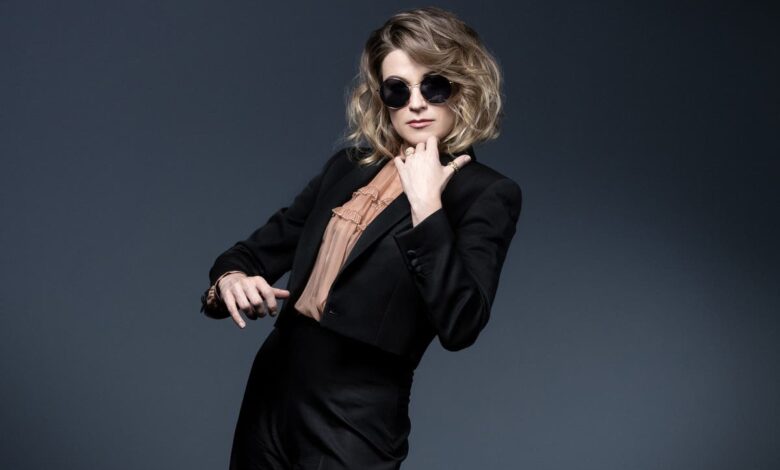Melody Gardot: ‘What is the problem with an ass? It’s not a weapon’

The Melody Gardot I met 10 years ago felt like the Greta Garbo of jazz.
Cool, striking, blonde (usually), with a dramatic sense of style and a breeze-soft, mystery-filled, soulful voice that, three albums into her career, had established the American as one of the most admired singers of her time, she sat curled in the corner of a hotel dining room in central London. The drowsy afternoon atmosphere was amplified by the already-dim lights being wreathed in scarves.
There were more scarves draping the interviewee, and a turban, and hair that was very different from the cascade of black curls on display at the previous night’s classily theatrical concert at the grand Freemasons’ Hall in Covent Garden. The sunglasses stayed on throughout our encounter, as they had for the duration of the show. The walking cane with which she’d carefully entered the stage lay propped by her armchair.
“The biggest influence that I have at the moment is things like cabaret and burlesque,” the American told me in a feathery voice – although I was also aware that Gardot, 27 then, was still recovering from a traffic accident eight years previously. Back home in Philadelphia, where she was a fashion student at the time, Gardot had been knocked off her bicycle by a Jeep that shot a red light. Her injuries were devastating: shattered pelvis, spinal damage, severe head trauma. She was bed-ridden for 11 months and had to learn to walk again – and to live with the after-effects of neural damage, including memory loss and sensitivity to light, temperature and barometric pressure.
As to her coping with, and managing, her pain: “In very severe moments, ultrasound, Tens unit, shiatsu, acupressure, acupuncture, myofascial release, craniosacral, osteopathic manipulations – any of these works very well. And I can use them in a balanced way to pull myself back into shape momentarily.” A carefully controlled macrobiotic diet helped, too.
What a difference a decade makes. The Melody Gardot I meet in a bistro in the 16th arrondissement in Paris is a wise-cracking, chic, olive-green jumpsuit-wearing dynamo who strides across a boulevard with a swish of blonde mane (her own) and the clack of heels.
When I comment on how she looked and presented back then (“Oh God I had so many wigs!”), and start to commend her on her seeming physical reboot after a long period of strict regimes and regimens, she interjects with an airy “that’s changed”. And she is indeed a totally changed woman. Her fragile health is improved to the extent that she hasn’t had to shield during the pandemic. Well, not medically. She did feel overwhelmed with the nightly news bulletins on French TV, tallying up infections and fatalities in each country.
“To me, it was playing with people’s emotions, just enough to make fear so that when they gave instructions, people would follow them. That’s not a conspiracy thing – it’s the news in general. If you watch it in the news too, it’s all negative, negative, negative, negative.
“I’m too sensitive, so I needed to find a way to protect myself,” she continues, and she means it emotionally. “But I wasn’t worried about me [physically].” She’s still not had Covid and isn’t concerned about infection. “Nah!” she says, sounding very Philly. “Believe me, if a car can’t kill me, that ain’t gonna kill me.”
She does, I say, look immeasurably more robust.
“That a nice way of saying I’m a little fatter?” she cracks. “That’s Covid, man,” she adds of (non-existent) lockdown weight gain. “But, yeah, a little bit! I’m alright with it. Even cars need spare tyres, man.”
Gardot remains very much a star, but now cast in a very different light. The shades still stay clamped to her face, although now they’re more Presley than Piaf. And she does move us from one lunchtime venue to another – but not because the first doesn’t meet her rarefied needs. It’s too snobby, she frowns, indicating her disdain by flicking the tip of her nose like a schoolkid. And, after 10 days’ Covid-protocolled playing of European festivals in support of her exquisite new piano-and-vocals album, Entre Eux Deux, she needs earthier sustenance: omelette and chips.
Of summer 2022’s touring rules and regulations, “everything is kinda jump through hoops”, Gardot sighs as she parks her handbag on the seat next to her, packet of fags poking out. “Also, instead of having a tour bus – we weren’t able to acquire one – the minute you wake up, you get a taxi, a train, then another car, then arrive at the festival. And then you do the same again the next day. It’s really weird, we don’t usually travel on show days. And because you have those hours, you don’t get breakfast, lunch and dinner. So it’s been Hunger Games for the last 10 days!” she concludes, ultimately, cheerfully.
Hence the need for proper French bistro fare, including a fresh orange juice. “Un autre, s’il vous plaît,” she asks the waitress as she drains the first practically in a oner.
Entre Eux Deux is billed as a duo album, a collaboration with French-Brazilian pianist Philippe Powell. An accomplished player herself, on her sixth studio album, Gardot cedes control of the instrument to her collaborator (son of revered Brazilian guitarist Baden Powell). She focuses on the singing – the inhabiting – of a set of songs comprising Brazilian standards, French love songs and new, co-written compositions. It’s a very different record to 2020’s Sunset in the Blue, begun in Los Angeles with crack players and collaborators recording at the legendary Capitol Records Studios, concluded during lockdown with remote recordings by the Royal Philharmonic Orchestra at Abbey Road, and topped off with a duet with Sting.
Gardot with Dita von Teese, Christian Louboutin and Jacques Bungert during Paris Fashion Week 2020
“I just felt it was a bit like Warhol/Basquiat,” she says of her partnership with Powell in a manner that sounds way less bumptious than that might read. “Two people who are competent are working on a project together, and giving each other the space necessary to do so. That’s in terms of composition and recording, and in terms of the sound.”
How concerned was she that the lyrics would land with English speakers?
The briefest of pauses, and then, “Never thought about it, ha ha!” Gardot hoots. “But there’s English songs on the record! And music is international. So to me, the feeling is most important. This was the first record I produced, top to bottom, outside of the live one,” she says of 2018’s Live in Europe. “And I said to the engineer: look, people are either gonna love or not love these songs. But there’s one thing we have to make sure: that it sounds great.
“But I guess if you’re curious about what the songs mean, like watching a foreign film, you can look at the lyrics and translate them.”
Gardot performing at Monte Carlo Jazz Festival in 2015
The album cover for ‘Live in Europe’





